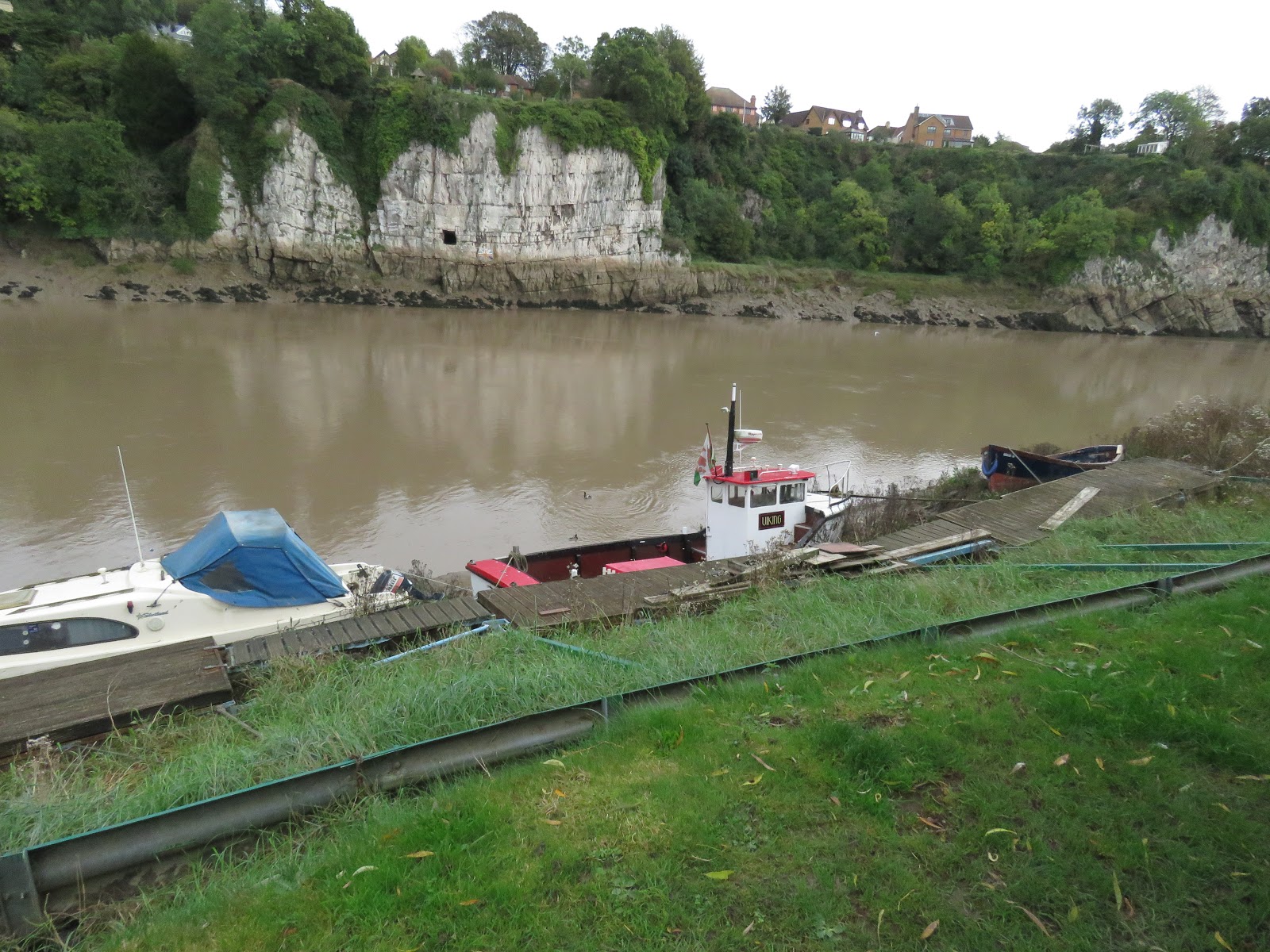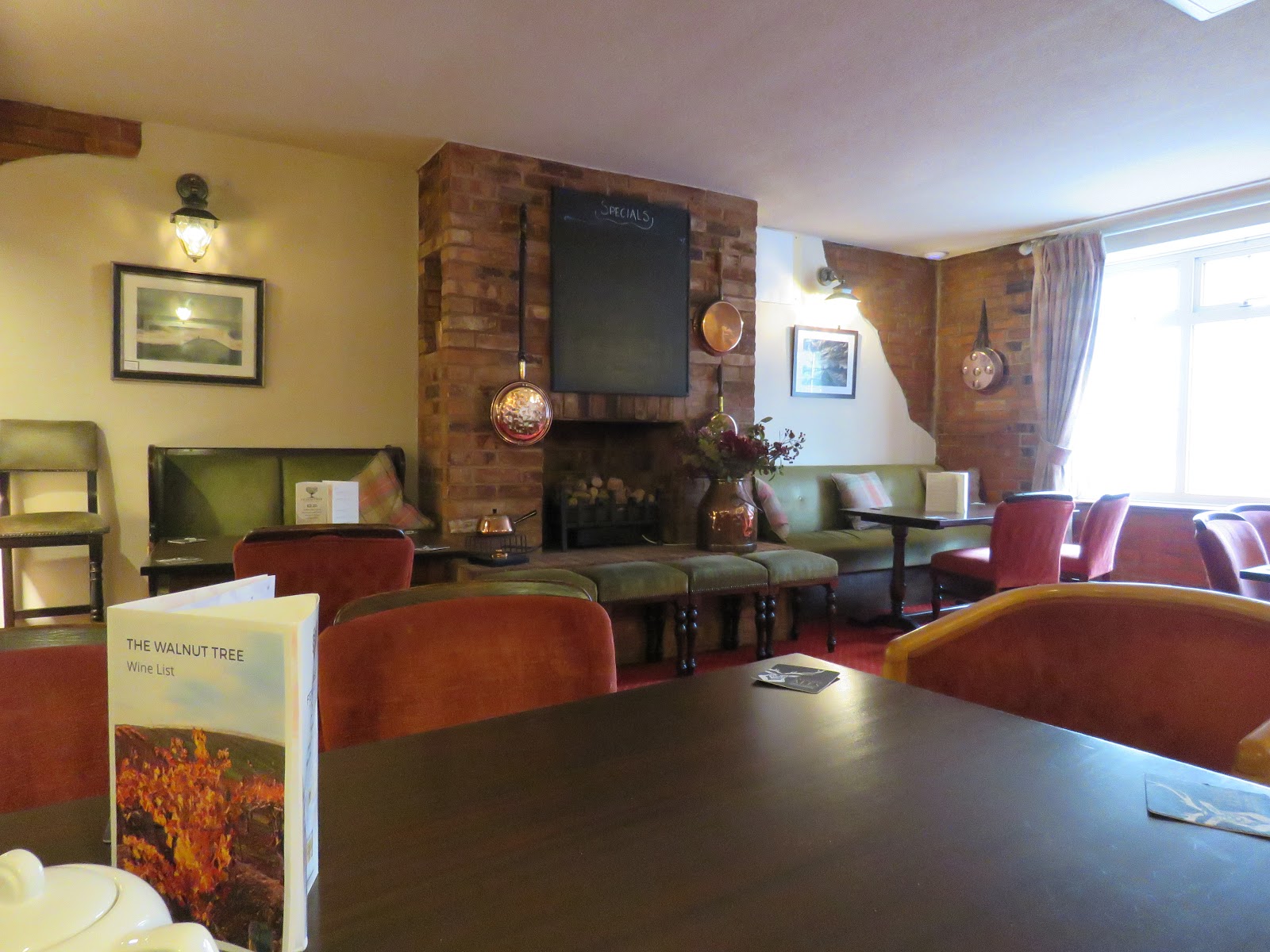 |
| The four of us in front of a large fireplace. |
From this site
The bedrock of Chepstow is limestone, mudstone, and sandstone, overlain in places with some gravels and the clay and silt of the river’s tidal flats, which are of marine origin and up to two million years old. Most of the rock was produced in a warm, tropical marine environment when Europe was closer to the equator. The rock of Sedbury cliffs and those under Chepstow Castle are carboniferous limestones, hundreds of metres deep in the area, made of particles and shells of sea creatures from 330-360 million years ago. Layered outcrops of darker Black Rock limestone, which makes up a broad part of Chepstow’s bedrock, are very clear in cliffs along Craig Yr Afon, part of the Wales Coast Path extending from Wyebank Road, and by the link road from Bulwark Road to the M48, where the looser reddish Mercia Mudstone (which extends under Bulwark and Sedbury and forms the cliffs at the Severn) and the lighter Hunts Bay limestone are also seen.
The River Wye at Chepstow has one of the highest tidal ranges in the world.[18] The river was established as a boundary between England and Wales by Athelstan in 928. However, after the Norman conquest, areas east of the Wye, within the former Saxon royal manor of Tidenham and including Beachley, Tutshill, Sedbury, and Tidenham Chase, were included within the lordship of Striguil or Chepstow. In 1536, the river was confirmed as the boundary between Monmouthshire and Gloucestershire. Since the early 19th century, housing development has continued on the east bank of the river opposite Chepstow, at Tutshill and Sedbury. Those areas, though located in England rather than Wales, are now effectively suburbs of the town.”
 |
| By crossing this bridge, near the Boat Inn Restaurant in Chepstow, we left Wales and entered England. |
| Expense | US Dollar | GBP |
| 4 Holiday Rentals | $ 8,381.40 | $ 6,426.17 |
| Southampton Hotel (2) | $ 276.94 | $ 213.35 |
| Car Rental + Fuel | $ 1,985.64 | $ 1,529.73 |
| Dining Out | $ 675.07 | $ 520.07 |
| Groceries | $ 1,502.48 | $ 1,157.50 |
| Pharmacy | $ 478.20 | $ 368.40 |
| Tours | $ 42.00 | $ 32.36 |
| Total | $13,341.73 | $10,247.58 |
| Avg Daily- 62 ngts | $ 215.19 | $ 165.28 |
When we look back over the past two months, mostly spent in England and most recently in Wales, we can’s help but smile, grateful that we changed our usual plan of staying in one location for longer periods.
The two weeks in Falmouth overlooking the Atlantic Ocean’s Falmouth Bay, the two weeks we lived on a farm in both St. Teath, Cornwall and then three more weeks on a farm in Witheridge Tiverton Devon and then in Chepstow, Wales have all been outstanding experiences.
 |
| This breathtaking renovated room in Chepstow Castle, may have been used as a bedroom. |
These shorter-term stays have definitely inspired us to continue booking short term stays as we move forward into the future. The next bookings we are yet to arrange are for India beginning in February after our upcoming train tour on the Maharajas Express, a luxury train journey from Mumbai to Delhi.
As mentioned earlier, we decided to stay in hotels during our almost two remaining months after the six-night train excursion. Our next booked adventure is a Viking Ocean cruise from Mumbai India on April 3, 2020, ending in Greenwich, England on May 2, 2010.
 |
| The four of us in front of the Raglan Castle. |
From there, at this point, we have no plans other than the cruise on November 10, 2020, departing from Lisbon, Portugal, ending on December 2, 2020, in Cape Town, South Africa. We’ve yet to hear back from immigration if they’ll let us return.
 |
| The two castles presented a different perspective of life in medieval times. |
Once we hear from immigration, we’ll be able to book plans between May 2020 and December 2020. It makes no sense to book anything until we know if we can return to South Africa.
In the interim, right now we’re thinking in terms of the upcoming two nights in Southampton and the upcoming 15-night cruise to the US. Tonight, while in Southampton, we are having dinner with Kim and Keith who found us and our site from reading Tom’s posts on Cruise Critic several years ago.
 |
| Ken and Tom at Chepstow Castle. |
As the time nears to our two months in the US, we get excited at the prospect of seeing family and friends in Minnesota, Nevada, and Arizona. We’ve yet to book flights for these locations, preferring to “play it by ear” while we’re there. It will all work out, one way or another.
In a matter of moments, we’ll be heading out the door to make the two-hour drive from Monmouthshire to Southampton and begin the next phase of our travels.
 |
| Our two castle tours were delightful, especially with friends Linda and Ken |
We’re so grateful to be in a position to continue to treasure our life of world travel for however long we can and for the opportunity to share it all with our readers.
We’ll be back tomorrow from the Leonardo Royal Southampton Grand Harbour hotel, a stone’s throw from the cruise terminal, rated four stars. It looks fabulous online at this link. Of course, we add photos in a few days.
 |
| We were very content with our Shirenewton rental, conveniently located to downtown Chepstow. |
As for our above total expenses for the 62-nights we spent in the UK, we’ve yet to add fuel for the trip to Southampton and meals for two days, nor the upcoming cruise. We’ll do a separate “total expenses” when the cruise ends.
May your day be rich in experience and love.
 |
| The next day Tom and I and Tom and Lois visited Lisa at her home in Marloth Park where, as a volunteer with Wild & Free, she rescues and releases bush babies. Such dedication. For more photos, please click here. |














































































